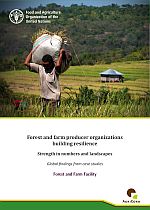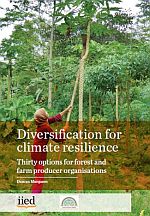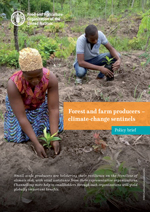Building climate resilience among forest and farm producers
Key messages
- Forest and farm smallholders supply at least one-third of the world’s food and face increasingly difficult climate conditions. These include temperature extremes, more variable rainfall, droughts, storms, flooding, pest and disease outbreaks.
- Forest and farm producer organizations – member organizations, such as cooperatives, which bring together communities, private smallholders and indigenous peoples – are well-placed to help their members overcome the huge challenges posed by climate change through training, advocacy and other support services.
- FAO, IIED and AgriCord call for an immediate upsurge in climate finance for these organizations to build vital resilience into smallholder livelihoods, landscapes and food systems. The benefits will be felt at a planetary scale.
Key findings
Forest and farm producer organizations building resilience – strength in numbers and landscapes This publication draws together global findings from a series of twelve case studies of forest and farm producer organizations in Africa (9), Asia (3) and Latin America (2). They focus on solutions, best practices, and models which could be scaled up to build climate resilience.
| |
Diversification for climate resilience -Thirty options for forest and farm producer organizations This publication presents 30 practical climate-resilience options for forest and farm producer organisations. They are based on climate-resilience literature and 10 previously published international case studies of organizations supported by the Forest and Farm Facility in Bolivia, Ecuador, Ghana, Kenya, Madagascar, Nepal, Tanzania, Togo, Vietnam and Zambia.
| |
Forest and farm producers – climate-change sentinels This policy brief is a synthesis of the FAO/AgriCord and IIED publications. It summarizes key findings and sets out six clear recommendations for how to build long-term climate resilience among smallholders.
| |
30 resilience options – diverse ways for grassroots organizations to flourish in the face of climate change This infographic summarizes the 30 practical climate-resilience options from the IIED report in an easy-to-digest visual format.
|




